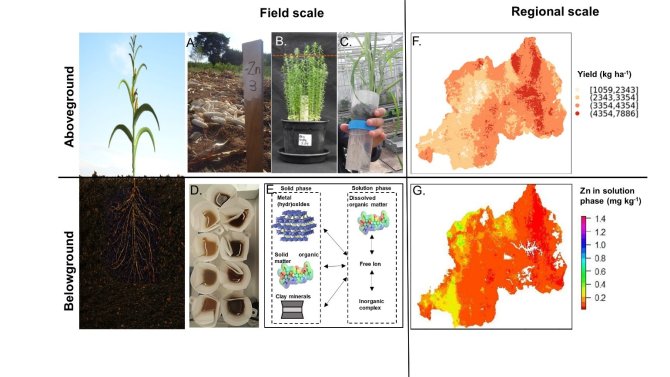Micronutrients for better yields (SSC)
Micronutrients for Better Yields is a collaboration between Soil Science cluster groups, research organisations and societal partners. It demonstrates highly technical research approaches to develop practical products/information for farm-level use to improve resource management, food production and livelihoods.
Background
Global food security is threatened by the yield-limiting availability of nutrients. In Sub-Saharan Africa (SSA), farmers face decreasing crop response to regular chemical fertilisers, believed to be caused by low micronutrient availability. Low micronutrient availability affects crop yield, grain quality and consequently human health – particularly in developing countries, where micronutrient malnutrition affects much of the population. Better understanding of soils’ intrinsic capacity to store and provide nutrients to crops, and crop response to fertilisation, is essential. This knowledge can be translated into applicable diagnostic tools and spatial data for relevant soil and agronomic properties, to provide economically feasible fertiliser recommendations at field and regional scales.
Objectives
The first aim of the ‘Micronutrients for Better Yields’ project is to understand soil chemical processes controlling micronutrient availability (zinc, copper, boron) in various SSA soils. This knowledge is used to develop accessible models for predicting soil micronutrient availability which will be based on input variables obtainable through routine soil analysis. The second aim is to develop a field-scale fertiliser recommendation system addressing yield-limiting micronutrients and digital soil maps of SSA micronutrient availability. To this end, the existing soil fertility tool QUantitative Evaluation of the Fertility of Tropical Soils (QUEFTS) is used. Our aim is to extend QUEFTS, currently calibrated for nitrogen, phosphorus and potassium, with micronutrients modules. Digital maps related to micronutrient availability will be developed in collaboration with ISRIC, using existing soil maps, QUEFTS and other derived models.
Approach
Figure 1 shows a schematic overview of this project. To better understand plant micronutrient uptake, belowground processes are investigated. This requires extensive soil samples characterisation (Figure 1D), including different nutrient fractions and quantification of soil reactivity for nutrient adsorption. Micronutrient adsorption to each major reactive surface in tropical soils is studied and parameterised using geochemical multi-surface models (Figure 1E). These complex models are translated into accessible prediction tools in the form of empirical partition relations. Existing soil maps are used as input in these partition relations to develop soil maps that predict nutrient concentration in solution, as shown for Zn in Rwanda (Figure 1G).
Moving aboveground, crop uptake is used as an indicator for micronutrient bioavailability in soils. Micronutrient fertiliser omission trials with maize were launched in Kenya, Zambia, Zimbabwe and Ethiopia, in collaboration with local partners. Yields are compared between treatments receiving complete fertilisation and treatments leaving out individual micronutrients, to assess whether they limit maize yield and to relate crop micronutrient uptake to soil properties (Figure 1A). Pot experiments with micronutrient fertiliser omission were also conducted (Figure 1B and 1C). Knowledge derived from field trials and pot experiments is used to extend the QUEFTS model by developing micronutrient modules. Maps can be developed with QUEFTS, like the predicted maize yield for Rwanda shown in Figure 1F. Once QUEFTS is extended with micronutrient modules, similar maps can be developed and used for generation of micronutrient fertiliser recommendations.

Highlights
Bioavailability of boron is generally considered to be controlled by adsorption to reactive minerals such as ferrihydrite, but previously this adsorption process had not been described. We studied the interaction of boron with ferrihydrite nanoparticles omnipresent in soil systems.[1] We confirmed that phosphate reduces boron adsorption and changes surface speciation. The derived ferrihydrite adsorption parameters were used in a geochemical multi-surface model to understand which surfaces are important for boron adsorption.[2] Compared to previous attempts, our approach enables a strongly improved mechanistic understanding of boron speciation in soils. Similar output will be generated for zinc and copper.
Transfer functions were developed for phosphorus and potassium soil tests[3]. QUEFTS requires four input parameters, of which two (pH and organic carbon) are routinely measured. For phosphorus and potassium availability, several soil tests are employed, giving varying results depending on the method. In order to apply QUEFTS to existing soil maps, transfer functions were needed, so that available phosphorus and potassium data could be translated into QUEFTS-required input. These functions greatly increase QUEFTS applicability.
Impact
Assessing micronutrient bioavailability is analytically challenging, especially given the extremely low concentrations in African soils. Accessible tools for predicting soil micronutrient availability are therefore expected to have great impact. These tools, supported and validated by mechanistic geochemical models developed in this project, can develop maps at regional and national scale. These maps enable identification of regions at risk of micronutrient-induced growth limitations and, consequently, development of effective fertiliser recommendations, which are indispensable for increasing yields and resource management in SSA and which improve human livelihoods.
[1] Van Eynde, E., Mendez, J. C., Hiemstra, T., & Comans, R. N. (2020). Boron adsorption to ferrihydrite with implications for surface speciation in soils: Experiments and modeling. ACS Earth and Space Chemistry, 4(8), 1269-1280.
[2] Van Eynde, Elise, Liping Weng, and Rob NJ Comans. ‘Boron speciation and extractability in temperate and tropical soils: A multi-surface modeling approach.’ Applied Geochemistry 123 (2020): 104797.
[3] Mirjam S Breure, Elise Van Eynde, Bas Kempen, Rob NJ Comans and Ellis Hoffland. ‘Transfer functions for phosphorus and potassium soil tests and implications for the QUEFTS model’. Under review.